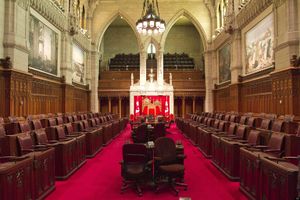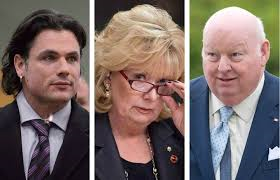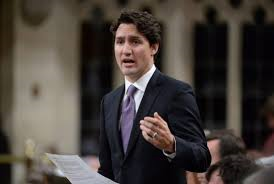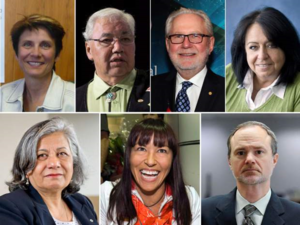Senate Reform
Background
The Canadian Senate, which is modeled after the House of Lords [1] in the United Kingdom, serves as the Upper Chamber in the overall structure of the Parliament of Canada[2]. Canada's Senate consists of 105 members, appointed by the Governor General of Canada[3] on the advice of the Prime Minister of Canada [4]. The 105 seats are distributed by region, with Ontario and Quebec receiving 24 seats, and the Maritime and Western provinces also receiving 24 seats.
Concerns over the Senate inclined dramatically during the Canadian Senate expenses scandal[5], which began in late 2012. Liberal Senator Mac Harb and Conservative Senators Patrick Brazeau, Mike Duffy, and Pamela Wallin all claimed invalid travel and living expenses. Later on, the Auditor General of Canada examined expense claims made by all Senators over a two-year period , and in June of 2015, released a report identifying 30 senators whose claims were inappropriate. The expense scandal was considered the national news story of 2013, with as many as 73% of Canadians following it closely. [1]
Party Positions
Following the expense scandal, Liberal Party of Canada leader Justin Trudeau announced on January 29, 2014 that all 32 Liberal senators would no longer be members of that party's caucus. Furthermore, Trudeau confirmed that, as Prime Minister he would reform the Senate appointment process to make senators independent, chosen by a non-partisan committee.
After several years of inaction on the senate reform file, the Conservative Party committed to appointed senators based on a list of elected candidates. This is only practiced in Alberta and British Columbia, therefore former Prime Minister Stephen Harper opted to ignore the issue of Senate Reform altogether. Following the Senate expense scandal, Prime Minster Stephen Harper did not appoint any new senators. [2]
The New Democratic Party has consistently called for the Senate's abolition, however in 2013, party leader Tom Mulcair would not answer whether he would appoint Senators if elected to government. [3]
Composition
Prior to the Senate expense scandal, the most controversial aspect of the Senate was not accountability, but rather composition. The unequal number of Senators from each province, as well as the lack of representation of minority groups were two major sources of debate.
This is particular controversial, given the fact that the Senate was created to counterbalance representation by population in the House of Commons. It was also intended to provide Parliament with a "sober second thought" when it came time to passing bills. Since the Senate is supposed to be representative of the Canadian population, its purpose also extended to ensure that all legislation respected minority rights. [4]
Provincial Representation
Under the Constitution Act, Senate seats are divided into 4 section: Quebec, Ontario, Western Canada and Maritime Canada. Each of these sections have 24 seats allocated. However, seat distribution by province has been a contentious issue that has ignited calls for reform or abolition by provincial leaders, including Premier Christy Clark of BC. [5]. Under the current system, British Columbia only has six senators, although it is the third largest province with a population of over 4.7 million. In comparison, the three maritime provinces with less than two million people combined are entitled to 24 senators.
Senate Seat Distribution By Province [6]
Quebec: 24 seats Ontario: 24 seats New Brunswick: 10 seats Nova Scotia: 10 seats Prince Edward Island: 4 seats British Columbia: 6 seats Alberta: 6 seats Saskatchewan: 6 seats Manitoba: 6 seats
Minority Representation
Looking at the composition of the Senate and comparing it to that of Canadian society, it is clear that the two are not reflective. For example, women make up over 50% of the Canadian population according to the most recent census, however they only account for 27.6% of Senate seats. In terms of visible minority representation, minority groups compromise over 24% of Canada's population, whereas minorities in the Senate represent a mere 12% of seats. [7].
Another notable lack of representation exists when it comes to age, where the median age in Canada is 40.6, whereas the median age of a Senator is 67.
While there has been progress when it comes to representation of the LGBTQ community, as well as the Indigenous communities in Canada, the same cannot be said for the representation of women, young peoples, and visible minorities. [8].
Reform
Under Justin Trudeau's new Government, on December 5, 2015, Minister of Democratic Institutions Maryam Monsef and House Leader Dominic LeBlanc announced a major change in the Senate appointment process, which the Liberal Party had campaigned on during the 2015 election. This new system would include a non-partisan committee of five board members - three federal and two provincial - who would pick independent candidate without any political affiliation, simply based on merit. [9]
A key part of this announcement was based around the fact that this process would not require a constitutional amendment, which is an issue that forced former Prime Minister Stephen Harper to avoid Senate reform altogether.
The first advisory board was appointed by the end of December 2015, with the criteria for appoint to the Senate set out as "...outstanding personal qualities that include integrity and ethics and experience in public life, community service or leadership in their field of expertise". [10]
On March 18, 2016, Raymonde Gagné, Frances Lankin, Ratna Omidvar, Chantal Petitclerc, André Pratte, and Murray Sinclair were chosen by the first advisory board to fill senate vacancies. These new appointments show a commitment to diversity and gender equity, as well as the promotion of minority rights.
Raymonde Gagné
She was the former president of Manitoba’s Université de Saint-Boniface. She was also awarded the Order of Canada for services to education and social services, and was a recipient of the Queen's Diamond Jubilee Medal. [11]
Frances Lankin
As a member Minister in the former Ontario NDP government and a national security expert, Ms. Lankin brings tremendous expertise to the Senate. She is currently a member of the Security Intelligence Review Committee, which is the watchdog for Canada's spy service.
Ratna Omidvar
She is an expert on migration and diversity, as well as the executive director at Ryerson University's Global Diversity Exchange. Ms. Omidvar was appointed to the Order of Ontario in 2005 and became a Member of the Order of Canada in 2011, with both honours recognizing her advocacy work on behalf of immigrants and devotion to reducing inequality in Canada. [12]
Chantal Petitclerc
She is a champion Paralympic wheelchair racer and Team Canada chef de mission at the Rio Paralympic Games. [13]
André Pratte
He was the lead editorial writer at Montreal newspaper La Presse from 2001 to 2015, winning three National Newspaper Awards. He is currently an emeritus editorial writer and an adviser to upper management at the Montreal media outlet. In 2009, Mr. Pratte co-founded The Federal Idea, a federalist think tank that aims to rebut the arguments put forward by Quebec sovereigntists and improve the image of federalism in the province. [14]
Murray Sinclair
Mr. Sinclair is a retired Manitoba judge and former chair of the Truth and Reconciliation Commission into residential schools. His Truth and Reconciliation Commission released its final report in late 2015, after years of testimony from victims. It included 94 “calls to action” to improve the lives of Canada’s indigenous people – all of which the Liberal government has promised to implement. [15]
References
- ↑ http://www.cbc.ca/news/politics/senate-scandal-puts-harper-s-brand-at-risk-poll-suggests-1.2304444
- ↑ http://www.ctvnews.ca/politics/senate-reform-what-s-stephen-harper-s-plan-1.1291188
- ↑ http://news.nationalpost.com/news/canada/canadian-politics/tom-mulcair-ambiguous-if-he-will-appoint-ndp-senators-if-party-wins-next-election
- ↑ http://sen.parl.gc.ca/portal/about-senate-e.htm
- ↑ http://www.cbc.ca/news/politics/clark-trudeau-senate-reform-1.3353128
- ↑ http://sen.parl.gc.ca/portal/about-senate-e.htm
- ↑ http://www.thestar.com/news/canada/2015/01/02/parliaments_lack_of_diversity_goes_beyond_race_gender_study.html.
- ↑ http://sen.parl.gc.ca/portal/about-senate-e.htm
- ↑ http://www.cbc.ca/news/politics/senate-advisory-board-non-partisan-leblanc-monsef-1.3348531
- ↑ http://pm.gc.ca/eng/news/2016/03/18/prime-minister-announces-intention-recommend-appointment-seven-new-senators
- ↑ http://www.theglobeandmail.com/news/politics/trudeau-set-to-appoint-seven-new-senators/article29285218/
- ↑ http://www.parl.gc.ca/SenatorsBio/senator_biography.aspx?senator_id=206052&language=E
- ↑ http://www.theglobeandmail.com/news/politics/trudeau-set-to-appoint-seven-new-senators/article29285218/
- ↑ http://www.theglobeandmail.com/news/politics/trudeau-set-to-appoint-seven-new-senators/article29285218/
- ↑ http://www.theglobeandmail.com/news/politics/trudeau-set-to-appoint-seven-new-senators/article29285218/



